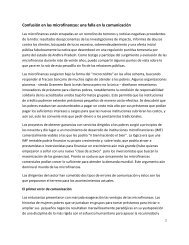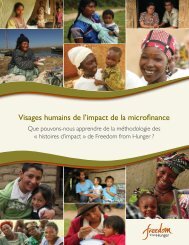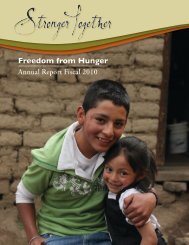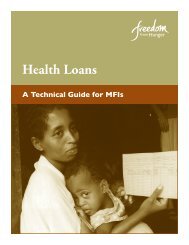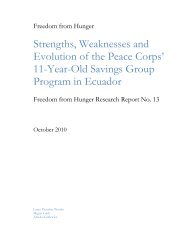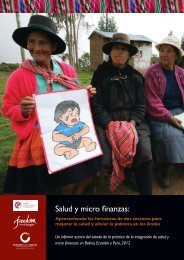history of meals for millions, soy, and freedom from ... - SoyInfo Center
history of meals for millions, soy, and freedom from ... - SoyInfo Center
history of meals for millions, soy, and freedom from ... - SoyInfo Center
Create successful ePaper yourself
Turn your PDF publications into a flip-book with our unique Google optimized e-Paper software.
corporation than they had been in the past.” For the first 9<br />
years, no board meetings occurred <strong>and</strong> “Florence Rose <strong>and</strong><br />
Ernest Chamberlain ran the Foundation substantially free<br />
<strong>from</strong> institutionalized control.<br />
Discusses the period <strong>from</strong> 1959-1961 <strong>and</strong> the influence<br />
<strong>of</strong> Mr. Robert Thompson, who in 1959, acting as a<br />
management consultant, <strong>of</strong>fered “to make a complete<br />
analysis <strong>of</strong> the structure, work, procedures, <strong>and</strong> finances <strong>of</strong><br />
the Foundation free <strong>of</strong> charge. His <strong>of</strong>fer was accepted. His<br />
very critical <strong>and</strong> partly inaccurate report had long-lasting<br />
repercussions that wracked <strong>and</strong> nearly wrecked MFM<br />
during the fall <strong>of</strong> 1961. By 1962 a “Special Committee <strong>of</strong><br />
the board agreed that “re<strong>for</strong>ms would enhance MFM’s fundraising<br />
capabilities.” One re<strong>for</strong>m was closer control <strong>of</strong><br />
spending. Everything came to a head at a Special Meeting<br />
<strong>of</strong> the Board <strong>of</strong> Directors on 28 Nov. 1961, in the Pine<br />
Room at Clifton’s Cafeteria, “when Florence Rose, Ernest<br />
Chamberlain, <strong>and</strong> Clif<strong>for</strong>d Clinton, apparently on the<br />
defensive,” threatened to resign if the directors implemented<br />
the Special Committee’s recommendations. After things<br />
simmered down, new by-laws were adopted on 15 April<br />
1962; “a highly centralized structure <strong>of</strong> policy <strong>for</strong>mation<br />
<strong>and</strong> control was established” (p. 24-36).<br />
Internal organization: Discusses the day to day working<br />
<strong>of</strong> the downtown Los Angeles <strong>of</strong>fice. “Here, assisted by 17<br />
administrative <strong>and</strong> clerical personnel, Miss Rose <strong>and</strong> Mr.<br />
Chamberlain strive to meet the many faceted dem<strong>and</strong>s<br />
which daily bombard their <strong>of</strong>fice.” “The functions <strong>of</strong> this<br />
staff divide into four categories: famine relief <strong>and</strong><br />
prevention; education <strong>and</strong> programming; fundraising; <strong>and</strong><br />
administration.” However these categories “defy any clear<br />
division <strong>of</strong> labor <strong>and</strong> partly because MFM suffers <strong>from</strong> a<br />
marked shortage <strong>of</strong> personnel (p. 38). Creation <strong>of</strong> an<br />
Auxiliary <strong>and</strong> receipt <strong>of</strong> pr<strong>of</strong>its General Mills derives <strong>from</strong><br />
its sale Formula B MPF. Attempt in 1962 to open an <strong>of</strong>fice<br />
on the east coast <strong>of</strong> the United States; it was closed after<br />
less than two years (p. 42). The center <strong>of</strong> activity would<br />
continue to be “Los Angeles, where the manufacturer <strong>of</strong><br />
MPF is located <strong>and</strong> where half a floor <strong>of</strong> Clinton’s has been<br />
provided without cost to the foundation <strong>and</strong> its staff.” For<br />
the next 14 years “the Foundation strove to preserve <strong>and</strong><br />
extend its contacts with representatives <strong>of</strong> agencies in the<br />
east by sending staff personnel on yearly cross-country<br />
trips” (p. 42-43).<br />
Discusses Mr. Fred Hafner <strong>of</strong> General Mills, the Food<br />
Banks Department, Dr. Donald Ebright (director <strong>of</strong> the<br />
Extension Services Department <strong>and</strong> an ordained minister; in<br />
1961 about one-third <strong>of</strong> MFM’s income came <strong>from</strong> church<br />
organizations); Mrs. Hazel Hopkins (who wrote over 6,000<br />
letters in 1960), Mrs. Jean Burden (head <strong>of</strong> the Public<br />
Relations Department, she wrote press releases, magazine<br />
<strong>and</strong> newspaper articles, <strong>and</strong> gathered material <strong>for</strong> the<br />
Foundation’s Newsletter). “MFM’s unquenchable thirst <strong>for</strong><br />
MEALS FOR MILLIONS, SOY, AND FREEDOM FROM HUNGER 84<br />
© Copyright Soyinfo <strong>Center</strong> 2011<br />
funds absorbs the attention <strong>of</strong> practically the entire staff” (p.<br />
45-48).<br />
Chapter 4. “Conflict <strong>and</strong> cooperation within the United<br />
States” [among organizations in the private sector] begins:<br />
“Meals <strong>for</strong> Millions, despite its status as an NGO, is first<br />
<strong>and</strong> <strong>for</strong>emost an American organization. No other<br />
characteristic means more because the vitality <strong>of</strong> the<br />
Foundation’s relief <strong>and</strong> prevention program depends<br />
directly upon the support it attracts <strong>from</strong> organizations <strong>and</strong><br />
individuals within the United States” (p. 50). More than<br />
“180 American non-pr<strong>of</strong>it organizations have throughout<br />
the years assisted MFM because they share its concern <strong>for</strong><br />
the welfare <strong>of</strong> undernourished people. In the commercial<br />
realm, first Gentry <strong>and</strong> now General Mills have per<strong>for</strong>med<br />
an indispensable service <strong>for</strong> MFM” by manufacturing its<br />
MPF. MFM had <strong>of</strong>ten abrasive relations with the National<br />
In<strong>for</strong>mation Bureau, a key non-pr<strong>of</strong>it agency that acts as a<br />
guardian <strong>of</strong> st<strong>and</strong>ards in the field <strong>of</strong> American<br />
philanthropy.”<br />
“In the summer <strong>of</strong> 1946, as Florence Rose, Ernest<br />
Chamberlain, <strong>and</strong> Hazel Hopkins sat in the basement arcade<br />
<strong>of</strong> Clif<strong>for</strong>d’s Restaurant s<strong>and</strong>wiched between the parlors <strong>of</strong><br />
a tattoo artist <strong>and</strong> a <strong>for</strong>tune teller, <strong>and</strong> plotted the tactics they<br />
would use to breathe life into their infant organization, they<br />
must have realized the enormity <strong>of</strong> their responsibilities.”<br />
For one <strong>of</strong> their highest priorities was to win MFM a share<br />
<strong>of</strong> the money donated by the American people to charitable<br />
organizations. For example, the previous year, the huge <strong>and</strong><br />
well-known American Red Cross had spent more than $4<br />
million on “public in<strong>for</strong>mation <strong>and</strong> educational relations”<br />
plus an equal or greater amount <strong>for</strong> “membership<br />
enrollment <strong>and</strong> fund raising.” Having only a portion <strong>of</strong> the<br />
$40,000 pledged by Clif<strong>for</strong>d Clinton, Edmond Clinton,<br />
Ransom Callicott, <strong>and</strong> Clifton’s Restaurant <strong>for</strong> working<br />
capital, the trio realized that MFM needed, yet could not<br />
af<strong>for</strong>d, extensive publicity to attract donations. But the<br />
problem <strong>of</strong> finances <strong>and</strong> publicity, however compelling,<br />
distressed Miss Rose <strong>and</strong> Mr. Chamberlain no more than the<br />
plight <strong>of</strong> the people suffering <strong>from</strong> the after-effects <strong>of</strong> the<br />
Second World War” (p. 52-54).<br />
A long paragraph describes the extent <strong>of</strong> hunger<br />
reported in Europe <strong>and</strong> India.<br />
“Impelled by the practical need <strong>for</strong> money <strong>and</strong> the<br />
humanitarian desire to aid the starving, MFM’s staff hit<br />
upon the deceptively simple tactic <strong>of</strong> <strong>of</strong>fering MPF free to<br />
agencies <strong>and</strong> individuals engaged in relief activities. Their<br />
plan, if successful, would permit MFM to speedily put MPF<br />
into the battle against hunger without an expensive staff <strong>and</strong><br />
would give the Foundation the publicity it needed to attract<br />
contributions <strong>from</strong> the American public. In effect, they were<br />
gambling that overburdened <strong>and</strong> understaffed relief<br />
agencies, though unfamiliar with the nutritional properties<br />
<strong>of</strong> MPF or the program <strong>of</strong> MFM, would: (1) accept a<br />
shipment <strong>of</strong> MPF, (2) use it properly, (3) recognize its



